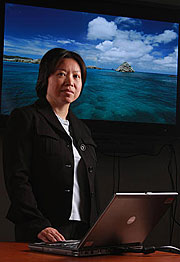- Number 292 |
- August 4, 2009
PNNL’s Ruby Leung Makes Models Smarter about the Climate

Lai-Yung (Ruby) Leung
Few problems have galvanized the global scientific community as much as climate change and its consequences. Policy makers and resource managers worldwide need sound scientific knowledge to make informed decisions about climate and energy, particularly at the regional level.
At DOE’s Pacific Northwest National Laboratory, Lai-Yung (Ruby) Leung is at the forefront of regional climate modeling research. Leung is a fellow of the American Association for the Advancement of Science and laboratory fellow at PNNL. She has earned international recognition for discovering unexpected impacts of regional climate change. For example, she was the first to quantify the vulnerability of snowpack in warmer climates of the Pacific Northwest and its effect on water resources, important to energy production and endangered wildlife.
Leung developed a new approach to downscaling key climatic processes from global to local grids. She simulates events at the “subgrid” scale inside the larger modeling grids typically used in climate models. The result is models that reveal climate effects at unprecedented levels of detail and accuracy. Leung’s method also dramatically reduces computational time for modeling. This breakthrough in computational efficiency greatly advances knowledge of the range of impacts and potential options for managing global warming.
Leung contributed to scientific assessments by the Intergovernmental Panel on Climate Change, which won the Nobel Peace Prize for 2007. Leung is developing a next-generation regional climate model that will help transform the world’s ability to predict climate change and its impacts, in collaboration with organizations such as the National Center for Atmospheric Research and the National Climate Center of the China Meteorological Administration. She also leads the task on mega-drought for DOE’s multi-laboratory project, Investigation for the Magnitudes and Probability of Abrupt Climate Change.
Science, Popular Science, Wall Street Journal, National Public Radio, and many other news outlets have featured her research.
Submitted by DOE's Pacific Northwest National Laboratory
